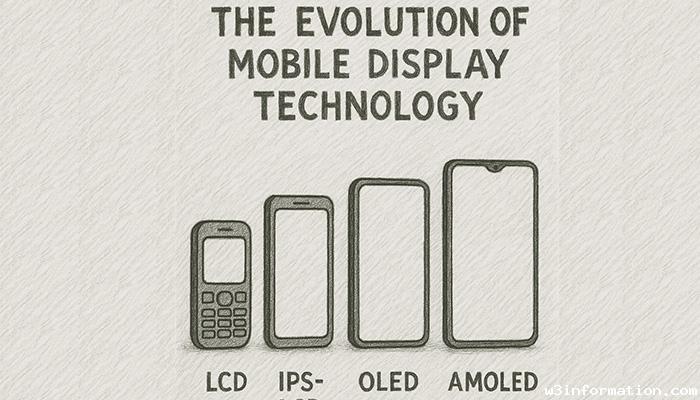The Evolution of Mobile Display Technology
Since mobile phones first appeared on the market mobile display technology has made tremendous advancements. The initial mobile phones came with tiny monochrome displays meant only for basic activities such as voice communication and text messaging. Modern smartphones rely heavily on mobile displays which showcase vibrant colors and high refresh rates while utilizing edge-to-edge screen designs. Mobile display technology advancements have completely changed device interaction through better visuals for gaming experiences, media consumption activities and productivity tasks. This blog will explore the development of mobile display technology beginning with its simple origins and leading up to the advanced features found in contemporary smartphones.
- The Early Days: Monochrome LCD Screens
- Color Displays: The Shift to Color LCD and TFT
- The advancement of smartphones required touchscreens with capacitive displays to enable user interaction.
- Full-Screen Displays: Bigger and Better Resolution
- Notch and Bezelless Displays represent advancements that maximize the screen area on smartphones.
- The Foldable Display: A New Era in Mobile Design
- Anticipated developments in mobile displays will feature advancements in 5G capabilities along with augmented reality technologies.
- Conclusion
- More Related Topics
The Early Days: Monochrome LCD Screens
The Beginnings of Mobile Displays
The initial mobile phones from the 1980s and 1990s featured basic monochrome LCD screens (liquid crystal displays) which supported text display and simple graphics. Early mobile displays were predominantly black and white with low resolution which constrained visual performance. The primary purpose of phones during this period was functional as users mostly made calls and exchanged brief text messages.

Key Features:
- Small display size (usually around 2–3 inches).
- Monochrome text and graphics.
- Low-resolution display (often 96 x 64 pixels).
Even though they faced significant limitations, these initial mobile displays laid the groundwork for today's advanced visual technologies.
Color Displays: The Shift to Color LCD and TFT
The Introduction of Color Screens
The late 1990s and early 2000s marked the evolution of mobile phones through color LCD screen implementation. The newly introduced displays enabled richer visual presentations which allowed users to view photos and colorful graphics alongside enhanced video playback. This technology represented a major advancement from the previous generation of black-and-white displays.
Key Features:
- Color displays for better graphics and visuals.
- Thin-Film Transistor technology enabled displays to display brighter and more vivid colors.
- Early models struggled with low resolution which at 176 x 144 pixels fell short by modern benchmarks.
- This period initiated a visually immersive mobile experience as devices began to support both wallpapers and simple games.
The advancement of smartphones required touchscreens with capacitive displays to enable user interaction.
The Touchscreen Revolution
The late 2000s saw a major transformation in mobile technology with the introduction of touchscreen smartphones. The 2007 release of the iPhone transformed industry practices with its innovative all-screen design and touch-responsive capacitive screen. Capacitive displays enabled direct phone interaction through tapping and swiping gestures while making physical buttons unnecessary. The transition to touchscreen technology transformed our mobile device interactions and prepared the path for subsequent high-definition larger displays.
Key Features:
- Capacitive touchscreens that responded to finger gestures.
- Multi-touch support, allowing for gestures like pinch-to-zoom.
- Screens measuring 3.5 to 4 inches enabled enhanced media consumption and web browsing capabilities.
The introduction of touchscreen mobile displays created new opportunities for mobile applications and games and transformed web browsing while expanding smartphone interactivity which helped launch the current mobile ecosystem.
Full-Screen Displays: Bigger and Better Resolution
The Shift to Larger and Sharper Screens
Mobile phone displays experienced rapid advancements throughout the decade of the 2010s. Smartphone displays became sharper while their sizes grew larger until Full HD (1080p) resolution became the standard. The introduction of OLED (Organic Light-Emitting Diode) technology improved visual displays by delivering deeper blacks and brighter colors while reducing energy consumption compared to regular LCD screens.
Key Features:
- Displays that support Full HD (1080p) resolution provide improved sharpness for both images and videos.
- OLED screens deliver superior contrast ratios and consume less power than standard displays.
- Flagship devices now display screens that have grown from 4.7 inches to larger than 6 inches.
- Devices evolved to feature edge-to-edge displays where screen bezels reduced significantly making the display the center of attention.
Smartphone innovation led to powerful media devices that deliver high-definition video playback along with vibrant, crystal-clear web browsing and gaming experiences.
Notch and Bezelless Displays represent advancements that maximize the screen area on smartphones.
Full-Screen Designs and the Notch
Manufacturers began reducing bezels to their smallest sizes in order to maximize screen real estate which ultimately resulted in the development of the notch design. The iPhone X introduced a display design that maximizes screen area by using a nearly full-screen format with a small notch at the top to accommodate the front-facing camera and sensors. The development of this technology gave rise to screens that spanned the entire display area to deliver deeper immersion levels.
Key Features:
- Notch displays and hole-punch camera cutouts lead to superior screen-to-body ratios.
- Bezelless design results in the screen occupying almost the entire front surface of the device.
- Larger aspect ratios (18:9, 19:9) for wider displays.
Despite the controversy surrounding the notch design it revolutionized screen design which led manufacturers to adopt hole-punch cameras and under-display cameras for seamless displays.
The Foldable Display: A New Era in Mobile Design
The Future of Mobile Displays: Foldable Phones
In recent years foldable displays stand out as one of the most thrilling advancements in mobile display technology. The introduction of foldable phones such as the Samsung Galaxy Z Fold and Huawei Mate X marked the beginning of a new era for mobile display technology. Users can enjoy a bigger screen by unfolding these foldable devices which still maintain their compact size when folded.
Key Features:
- Flexible OLED displays enable screens to bend and fold without sustaining damage.
- The multi-screen feature enables users to operate both the expanded large display and a more compact smaller screen.
- Foldable devices which maintain structural integrity through repeated folding and unfolding actions.
The evolution of mobile technology will be shaped by foldable displays which deliver innovative methods for smartphone interactions.
Anticipated developments in mobile displays will feature advancements in 5G capabilities along with augmented reality technologies.
What’s Next?
Mobile display technology progress together with 5G networks as well as augmented reality (AR) and virtual reality (VR) systems will spark more thrilling technological advancements. The next generation of mobile displays will achieve higher refresh rates while delivering improved HDR performance and creating more immersive AR/VR experiences that operate smoothly alongside smartphones.
- 5G Connectivity: The rollout of 5G technology will enable mobile displays to facilitate quicker streaming services and more responsive gaming and AR applications.
- AR/VR Displays: The mainstream adoption of AR and VR technology will result in widespread availability of displays that produce immersive experiences through foldable and transparent screens for mixed-reality interaction.
- Flexible and Transparent Displays: Devices that are yet to come might include rollable or transparent displays which will generate new possibilities for device form factors and user interactions.
Conclusion
The evolution of mobile display technology has progressed significantly beyond the simple black-and-white screens seen in early mobile phones. Modern smartphones come with large displays that produce vibrant high-resolution images to create immersive experiences for gaming, streaming videos and web browsing. The future of mobile displays promises great excitement because of innovations such as foldable screens along with AR/VR integration and 5G connectivity.
As technology advances we will see new smartphone designs and immersive features that will transform how we use our phones. Mobile display technology will experience significant advancements in the coming years which will create an exciting period for mobile users.
 How to Prepare for College: A Teenager’s Guide
How to Prepare for College: A Teenager’s Guide
 The Importance of Mental Health Awareness for Teens
The Importance of Mental Health Awareness for Teens
 Dealing with Social Media Pressure as a Teenager
Dealing with Social Media Pressure as a Teenager
 How to Encourage Teen Leadership in Your Community
How to Encourage Teen Leadership in Your Community
 The Power of Positive Peer Influence in Teenagers
The Power of Positive Peer Influence in Teenagers
 The Role of Grandparents in a Child’s Development
The Role of Grandparents in a Child’s Development